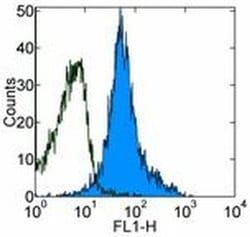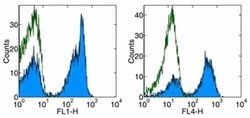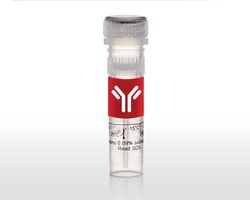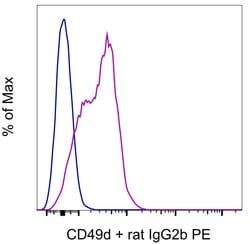CD44 Monoclonal Antibody (IM7), Functional Grade, eBioscience™, Invitrogen™
Rat Monoclonal Antibody
Manufacturer: Fischer Scientific
The price for this product is unavailable. Please request a quote
Antigen
CD44
Concentration
1 mg/mL
Classification
Monoclonal
Form
Liquid
Regulatory Status
RUO
Formulation
PBS with no preservative; pH 7.2
Gene Alias
AU023126; AW121933; AW146109; Bovine CD44; CD44; CD44 antigen; CD44 antigen-like protein; CD44 molecule; CD44 molecule (Indian blood group); CD44 protein; CD44 variant; CD44A; CD44-like protein; CDW44; cell surface glycoprotein CD44; Cell surface glycoprotein CD44 (hyaluronate binding protein); cell-surface glycoprotein; chondroitin sulfate proteoglycan 8; CSPG8; ECMRIII; ECMR-III; Epican; extracellular matrix receptor III; extracellular matrix receptor-III; GP90 lymphocyte homing/adhesion receptor; HCELL; hematopoietic cell E- and L-selectin ligand; heparan sulfate proteoglycan; HERMES; Hermes antigen; homing function and Indian blood group system; HUTCH-I; hyaluronan receptor; Hyaluronate receptor; IN; LHR; Ly-24; lymphocyte antigen 24; lymphocyte surface antigen precursor CD44; MC56; MDU2; MDU3; METAA; MIC4; PGP I; Pgp1; PGP-1; PGPI; PGP-I; Phagocytic glycoprotein 1; phagocytic glycoprotein I; putative Bos taurus CD44; RHAMM; sCD 44; sCD44; soluble CD 44; soluble CD44
Gene Symbols
CD44
Primary or Secondary
Primary
Content And Storage
4° C
Gene
CD44
Clone
IM7
Applications
Flow Cytometry, Functional Assay
Conjugate
Functional Grade
Host Species
Rat
Target Species
Human, Mouse
Gene Accession No.
P15379, P16070
Gene ID (Entrez)
12505, 960
Isotype
IgG2b κ
Purification Method
Affinity chromatography
Product Type
Antibody
Description
- Description: The IM7 monoclonal antibody reacts with all isoforms of mouse CD44 (Pgp-1)
- CD44 is expressed by hematopoietic and non-hematopoietic cells
- Bone marrow myeloid cells and memory T cells highly express this antigen and peripheral B and T cells can upregulate the expression of CD44
- CD44 functions as an adhesion molecule through its binding to hyaluronate, an extracellular matrix component
- Applications Reported: The IM7 antibody has been reported for use in flow cytometric analysis
- IM7 has also been reported in complement-dependent cytotoxicity
- Applications Tested: The IM7 antibody has been tested by flow cytometric analysis of mouse bone marrow cells and splenocytes
- This can be used at less than or equal to 0.125 μg per test
- A test is defined as the amount (μg) of antibody that will stain a cell sample in a final volume of 100 μL
- Cell number should be determined empirically but can range from 10^5 to 10^8 cells/test
- It is recommended that the antibody be carefully titrated for optimal performance in the assay of interest
- Storage and handling: Use in a sterile environment
- Filtration: 0.2 μm post-manufacturing filtered
- Purity: Greater than 90%, as determined by SDS-PAGE
- Endotoxin Level: Less than 0.001 ng/μg antibody, as determined by LAL assay
- Aggregation: Less than 10%, as determined by HPLC
- CD44 cell surface antigen is a 100 kDa type 1 transmembrane glycoprotein widely expressed on human leucocytes, white matter of the brain and by some epithelial cells of the intestine and breast
- Several isoforms of CD44 exist, including the predominant CD44H isoform detected in many normal tissues
- CD44 is a receptor for hyaluronic acid (HA) and is involved in cell-cell interactions, cell adhesion and migration
- CD44 also participates in a wide variety of cellular functions including lymphocyte activation, recirculation and homing
- CD44 expression may be up-regulated upon some carcinomas, and it has been speculated that this may be related to metastatic potential
- CD44 is expressed by hematopoietic, non-hematopoietic cells, epithelial tissues, and to filopodia in cultured keratinocytes
- Further, bone marrow myeloid cells and memory T cells express CD44 at high levels, and peripheral B and T cells can upregulate the expression of CD44 in response to certain stimulatory events
- Transcripts for the CD44 gene undergo complex alternative splicing that results in many functionally distinct isoforms, however, the full-length nature of some of these variants have not been determined
- Alternative splicing is the basis for the structural and functional diversity of the CD44 protein
- Diseases associated with CD44 dysfunction include superficial keratitis and lichen sclerosus
- CD44 also may be related to tumor metastasis formation.



